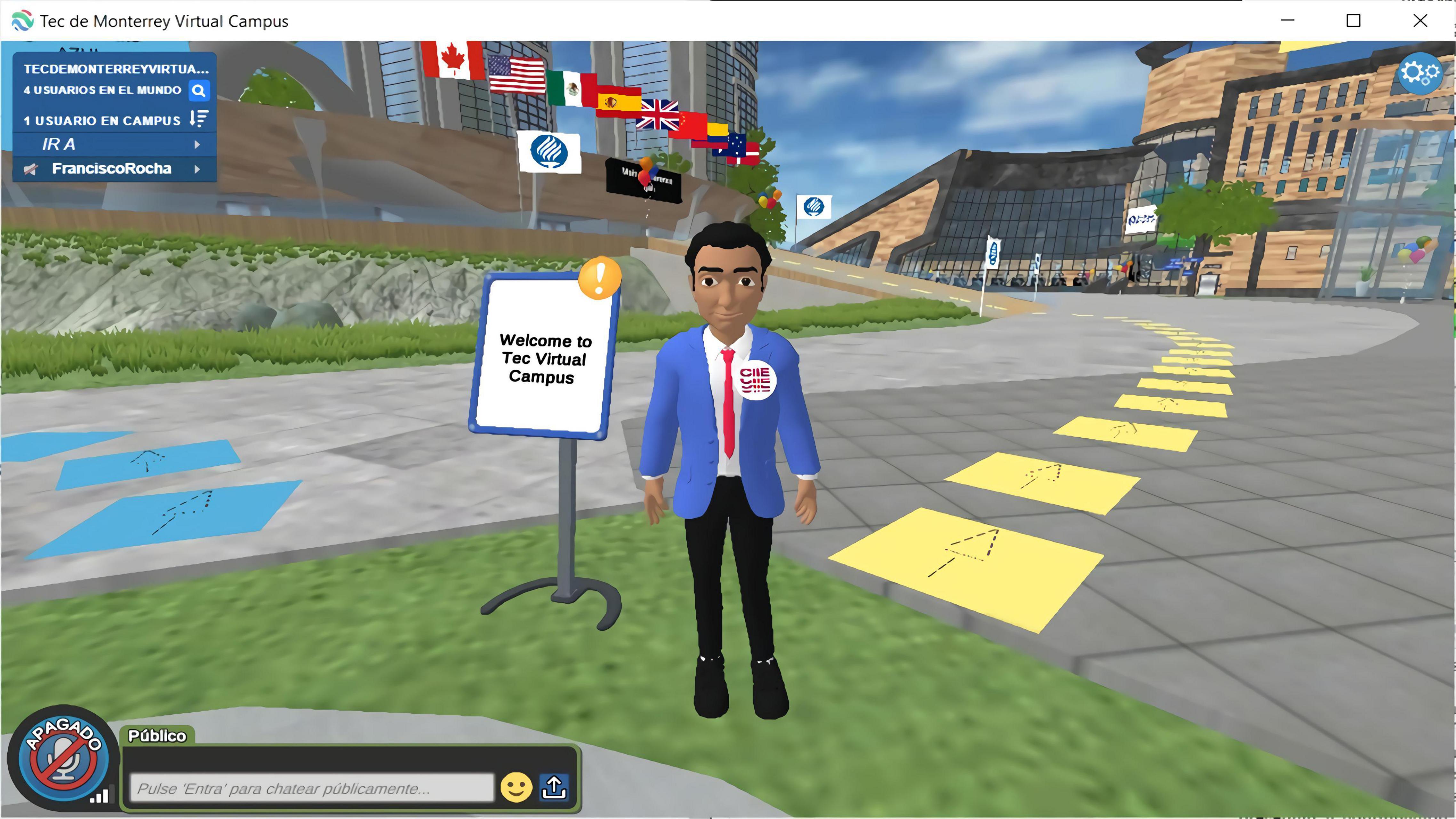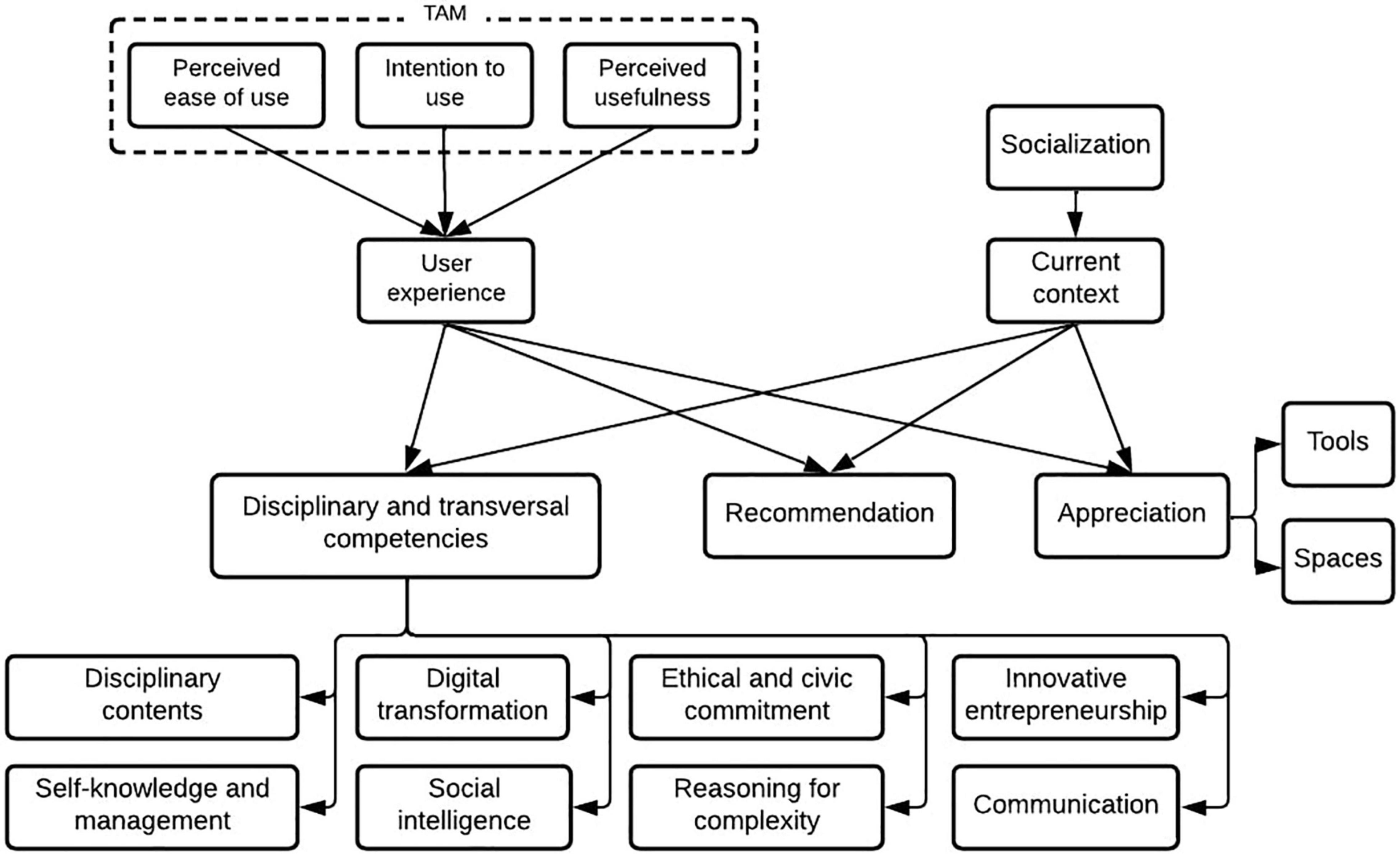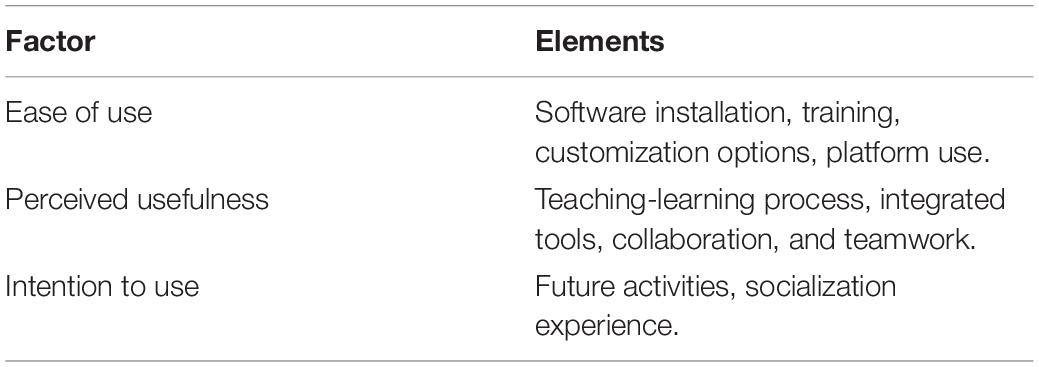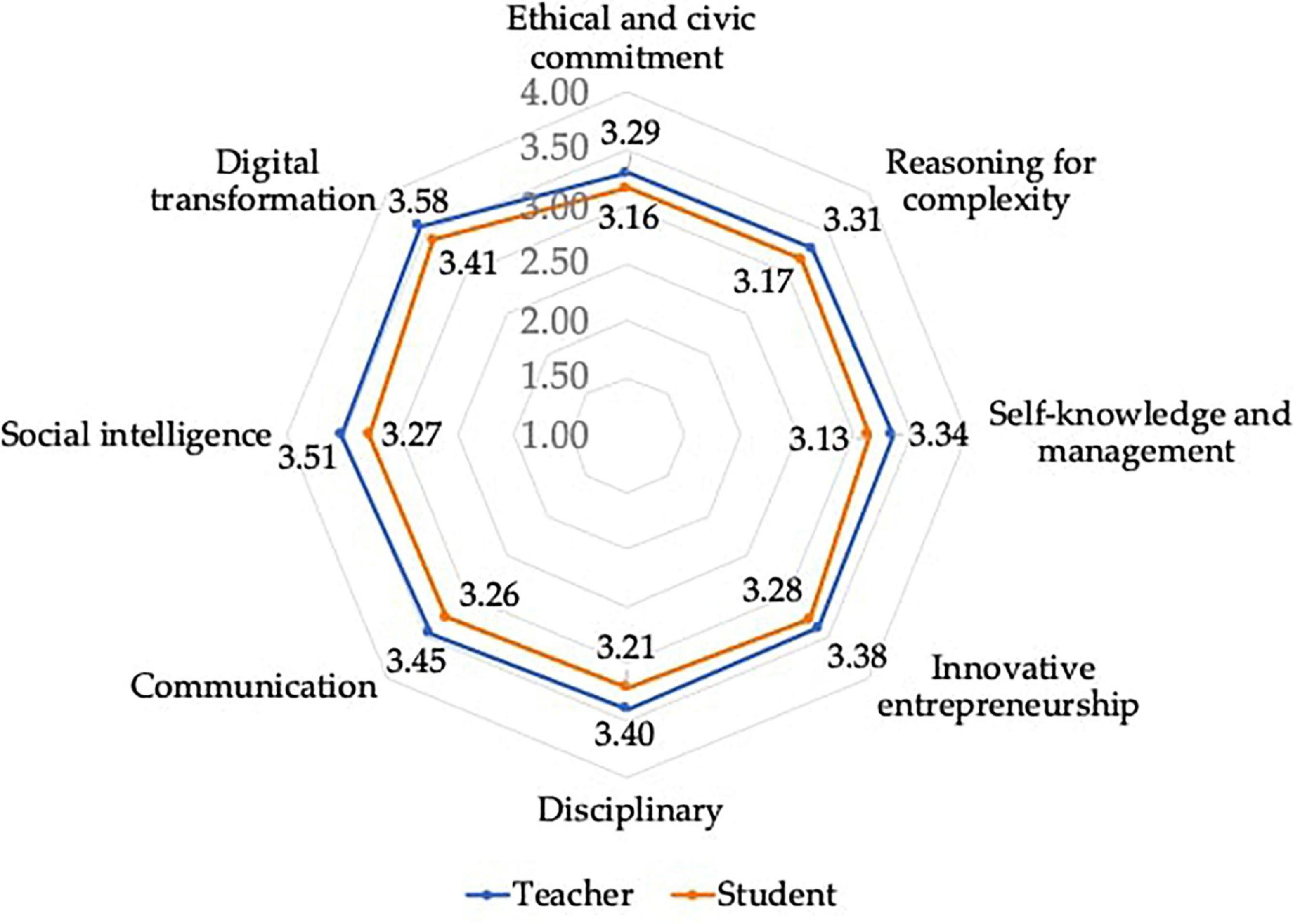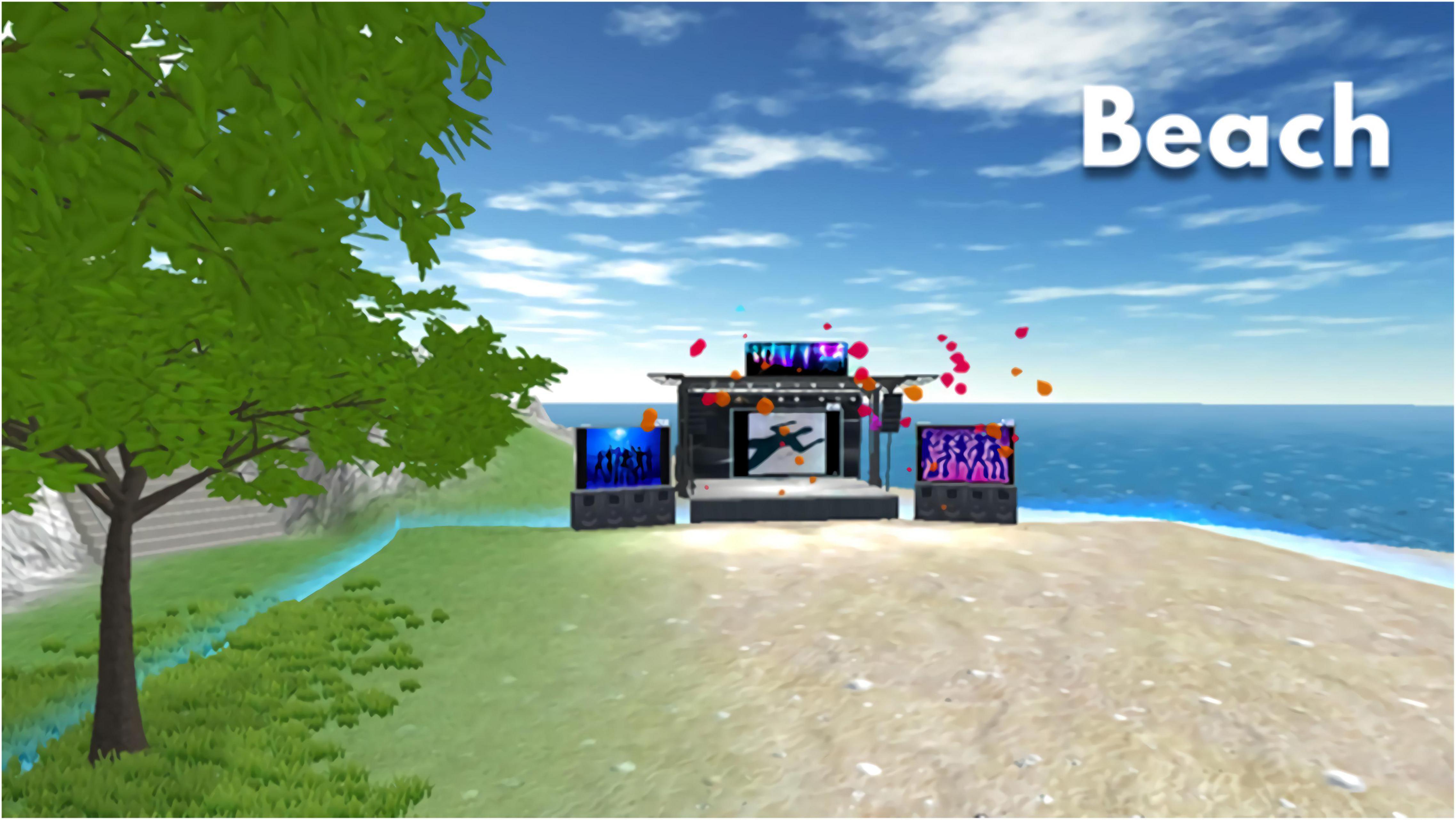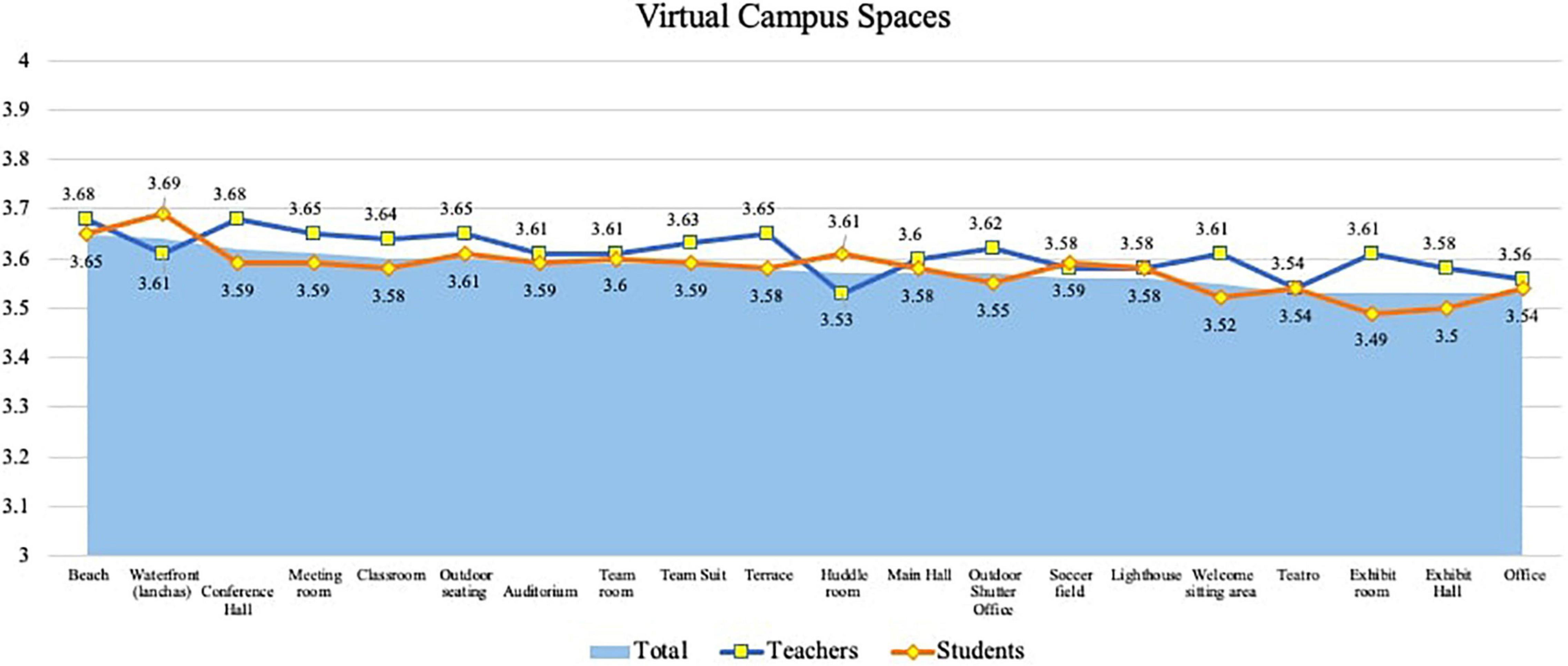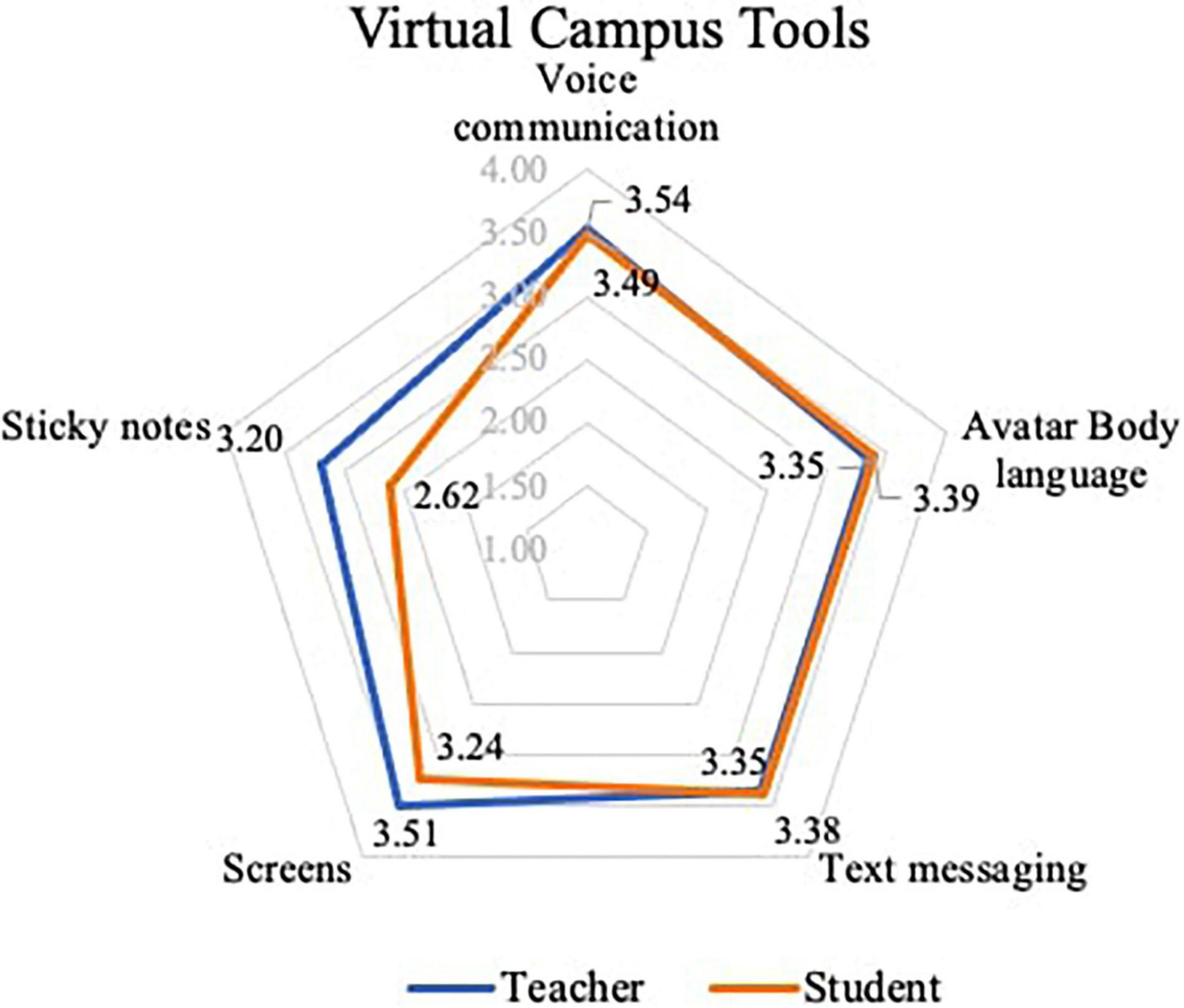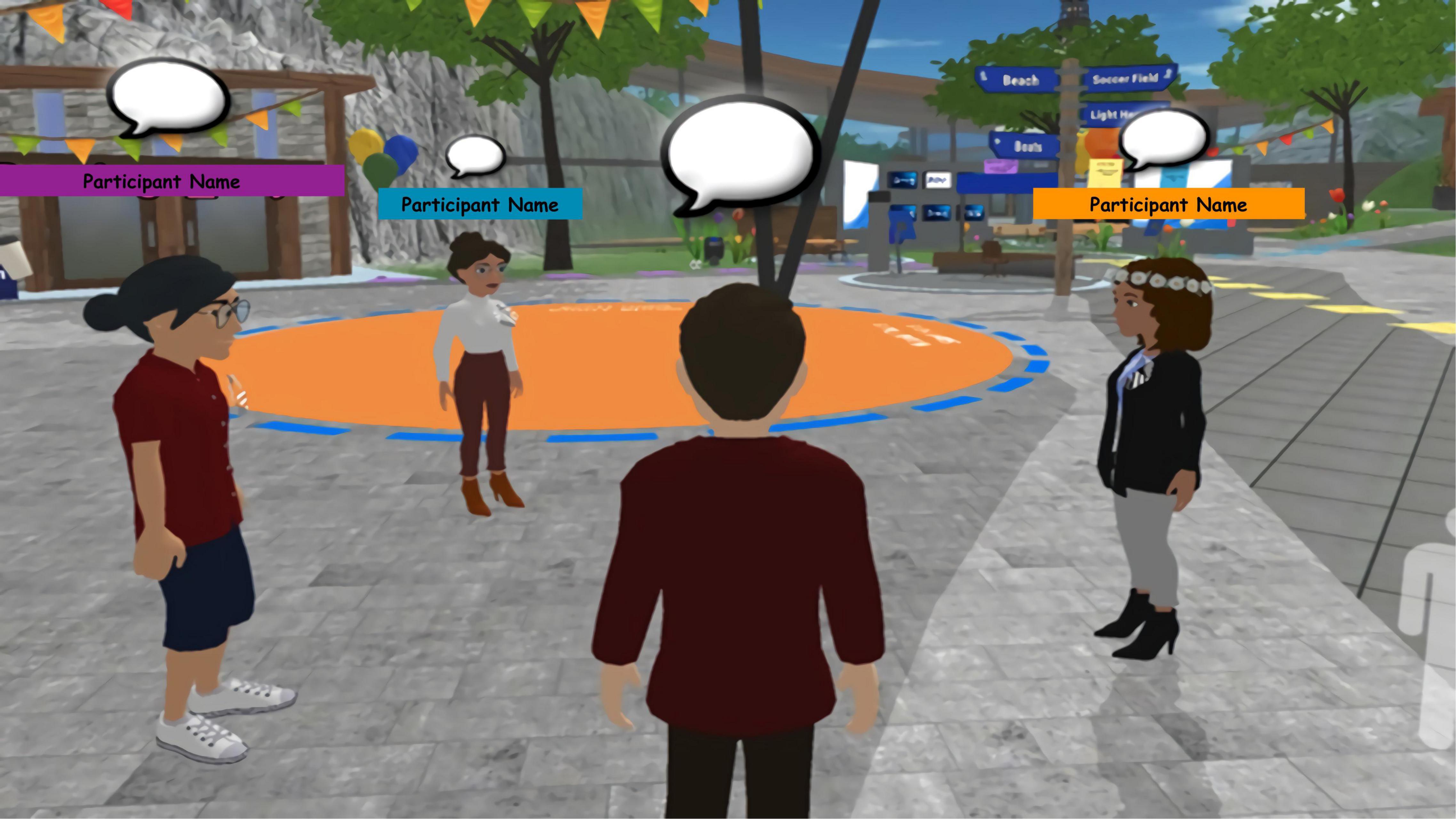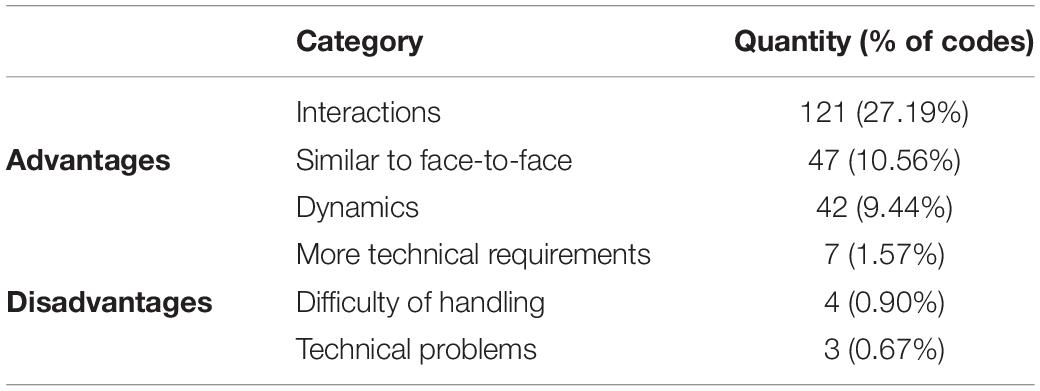- 1School of Humanities and Education, Tecnologico de Monterrey, Monterrey, Mexico
- 2Institute for the Future of Education, Tecnologico de Monterrey, Monterrey, Mexico
Educational institutions have continuously adapted to new realities in school education, accelerated recently by the COVID-19 pandemic’s transformation of learning modalities. This article analyzes teachers’ and Students’ acceptance of a web-based virtual reality (WebVR) tool called Virtual Campus proposed to overcome the limitations of teaching strategies using video conferencing platforms. To measure the acceptance of the Virtual Campus, we designed an instrument based on the Technology Acceptance Model (TAM) that involves variables related to online contexts, the future perception of using the tool, skills development, and appreciation and recommendation. The results indicate that the participants favorably accepted WebVR technology as an alternative teaching methodology in emerging learning scenarios and intend to use it post-pandemic. The best-valued elements were interactions in the socialization spaces, the simulation of presence, and the environmental dynamics. The principal areas of opportunity for improvement were overcoming technical problems and improving the internet connection quality; however, these did not affect the participants’ recommendations. Future studies should incorporate variables related to analyzing learning mediated by WebVR-based strategies and using different methodological designs to compare the findings.
Introduction
The COVID-19 virus forced educational institutions worldwide to migrate teaching-learning processes from traditional face-to-face teaching modalities to remote learning, adapting technological tools for educational innovations (Shaw et al., 2021), and supporting digital-skills development in students and teachers in diversified educational environments (Zhao, 2020).
Thus, digital technology was adopted for learning, communication, and socialization among students (Vuorikari et al., 2020). In this scenario, teachers found it necessary to articulate their academic practices through video-conferencing platforms using tools such as Zoom, Skype, Teams, Blue Jeans, or Google Meet to continue education and school activities (Sánchez et al., 2021).
Although this solution favored teaching-learning strategies and interactions among teachers and students, problems arose from the fatigue and stress of reading non-verbal signs (sometimes non-existent), the absence of emotions, silent sessions, and constant eye contact with the camera (Ebner and Greenberg, 2020; Nadler, 2020). This phenomenon has been called “Zoom fatigue”: teachers and students feel stressed from long sessions using digital devices with an absence of sensory stimuli (Cranford, 2020).
Some experts have stated that regardless of the educational modality of training processes, it is necessary to constantly offer students changes of stimuli (Peper et al., 2021) to manage non-presential teaching mediated by technologies. It is possible to reduce the feelings of isolation, anxiety, and depression caused by the cognitive load and the mental effort to establish effective communication among the participants of non-face-to-face teaching sessions (Bailenson, 2021).
As an alternative to reduce these phenomena and Zoom fatigue, some teachers have used web-based virtual reality tools (WebVR) to change the way they share knowledge with students. They also transform their teaching practices through strategies based on reality simulation (Videva et al., 2019). Regarding this, empirical studies have shown that WebVR technology is an attractive tool for displaying academic content, boosting Students’ participation and collaboration, and generating environments in which alternate learning simulations reduce the feeling of social isolation (Radianti et al., 2020; Jauhiainen, 2021; Mikhailenko et al., 2022).
Thus, learning mediated by the WebVR environment allows users to immerse themselves in simulated environments employing a realistic-looking multimedia scenario (Neroni et al., 2021). One aspect to consider when using WebVR technology is that it allows interaction in 3D spaces using personal computers, leaving external devices such as glasses or cardboard as an option (Vorobyeva et al., 2017). It has been confirmed that participating in this environment allows independent and collaborative learning and significantly supports Students’ knowledge development (Mora et al., 2020).
Web-Based Virtual Reality in the COVID-19 Environment
More than two decades ago, Heim (1998) stated that virtual reality had three fundamental value elements to be successfully incorporated into education: interactivity, immersion, and intensity of information. When the COVID-19 pandemic emerged, the meaning of this statement was confirmed because empirical studies revealed that VR offers the perception of learning by satisfying prevailing teaching needs during non-face-to-face training (Wolfartsberger, 2019; Sepasgozar, 2022).
The acceptance of WebVR technology has been evaluated in various contexts, like textual browsing in digital libraries (Hahn, 2018), visualizing complex structures in virtual laboratories (Xia et al., 2018) and designing immersive experiences in virtual museums (Oliver et al., 2019). In the case of academic training, this technology has been increasing because it has been proven to improve teaching and learning in various disciplines such as aeronautics, medicine, industrial safety, and others (Nemer et al., 2020). Thus, WebVR technology leverages the potential of three-dimensional elements and immerses teachers and students in simulated, realistic learning contexts (Christopoulos et al., 2020).
Some educational institutions have observed that virtual reality ceased being an idea of future education during the pandemic to become a present experience to develop and strengthen learning strategies (Allcoat and von Mühlenen, 2018; Zahabi and Abdul Razak, 2020). WebVR has been used during the pandemic with satisfactory results in educational research at the professional and postgraduate levels (Liang, 2020) disciplinary training (Mora et al., 2020; Cheng, 2021), linguistics (Jain et al., 2020), and for transferring knowledge immersively and interactively to people with special educational needs (Cardona et al., 2021).
This research starts with the premise that VR training processes implemented in higher education institutions need the Participants’ acceptance of this technology to be assessed (Akdere et al., 2021). Despite the benefits of using this technology, there is evidence that sensory immersion does not always offer positive experiences (Ferreira et al., 2021). Therefore, this research aimed to evaluate the acceptance of WebVR technology by teachers and students who participated in learning and socialization activities using this platform through the analysis of their experiences, to know if it represents a better option than the video conferencing tools for learning in online modalities.
Methodology
The study employed a mix-method, sequential exploratory approach with a descriptive logic and followed a QUAN-qual taxonomy (Creswell and Plano Clark, 2007). The concurrent procedure used by Díaz and colleagues was adapted to begin the data exploration and perform a quantitative analysis (Díaz et al., 2019). Subsequently, a qualitative study was conducted.
Participants
Although there are various WebVR platforms in cyberspace, one of the most used during the pandemic has been Virbela. It is a space of information and collaboration that impacts the reduction of costs related to the mobility of people and strengthens networking and new ideas among them (Jauhiainen, 2021).
At Tecnologico de Monterrey, a private, non-profit higher education institution in Mexico, an environment called “Virtual Campus” was designed on the Virbela platform, implemented to carry out video-conferenced training activities typically conducted face-to-face in regular sessions (see Figure 1). In this application, a university campus is simulated with closed areas such as buildings, offices, auditoriums and classrooms, and open spaces, including a soccer field, a beach, and a lighthouse. In this virtual reality environment, participants carry out academic and socialization activities.
The sample was non-probabilistic for convenience (Creswell, 2012). This research involved 262 students and 164 teachers participating in different training processes in the Virtual Campus during April and May 2021. The participants personalized their virtual identity avatars and attended induction sessions to explore the platform’s functionalities and collaborate in this environment’s teaching and learning activities.
The data collection techniques included a questionnaire with Likert-type and open questions that were applied once the professors taught their class or at the end of an academic activity for the students. Prior to the evaluation of the user experience in the Virtual Campus, a participant observation of the courses and training sessions was carried out and a field diary was recorded. To avoid bias in the self-reported data obtained in the questionnaire, the findings were triangulated between the different sources of information.
Instrument
Questionnaires are the most common methods to evaluate usability and user experiences in digital environments (Sousa and Lopez, 2017). We began with a systematic review of the literature to design the instrument used in this research, using the Scopus and Web of Science (WOS) databases. The result of this SRL allowed us to identify trends and various studies that suggest that the variables of perceived usefulness, ease of use, and intention to use are decisive in achieving a favorable acceptance of the implementation of the technology. Based on the above, the technology acceptance model (TAM) of Davis (1989) was used as primary references to build the instrument, the Tam is a solid reference framework used worldwide to evaluate the acceptance of various technologies in different contexts and despite the fact that it emerged several decades ago, it continues to be valid (Al-Emran and Granić, 2021), there is even an adaptation to virtual reality by Sagnier et al. (2020). However, this model has been criticized for ignoring processes related to socialization and interaction with other people (Benbasat and Barki, 2007).
To counteract this area of opportunity, this proposal incorporated socialization processes related to learning in the designing of the instrument, we added elements from our institution’s educational model called Tec21, these variables were disciplinary and transversal competencies (Tecnologico de Monterrey, 2022). We also included variables related to the transition from the non-face-to-face education caused by COVID-19, the appreciation of the different spaces comprising the Virtual Campus, the usability of the tools presented, and the degree of participants’ recommendations concerning the training experiences. This is possible because the Tam has proven to be a model capable of improving its explanatory power through the incorporation of new variables (Al-Emran et al., 2020). Figure 2 illustrates the dimensions in which these variables were integrated.
From this, we constructed an instrument called “Questionnaire to Evaluate the User Experience in Learning Spaces Mediated by WebVR Technology,” which can be consulted at the following link.1 To collect participant responses, we decided to use a Likert-type scale with four options so the respondents could select a position in favor or against each item. The instrument was validated per the expert judgment methodology proposed by Cooke (2014). The result can be seen in Table 1, where eight dimensions related to the acceptance of web-based virtual reality are described and 32 items emerging from these dimensions.
Procedure
The instrument was shared with the participants via email once their participation in the learning experience concluded. They were invited to review the informed consent notice, clarifying that personal data would not be collected, except the data necessary to understand the intentions of the study and that these would only be used to achieve the purposes of the research. The characteristics of the study were explained, and they were asked to respond voluntarily.
The Qualtrics platform was employed to collect and manage information from the respondents, which was configured in two profiles: (1) Student (based on student ID) and (2) Teacher (based on employee ID). The time frame for receiving responses was set to 2 weeks. Quantitative items were analyzed using descriptive and inferential statistics with Minitab software, while open coding was performed for the questions to find the most significant experiences about the advantages and disadvantages that the participants found when develop their activities using WebVR. The results presented below show the attendees’ experiences using the Virtual Campus.
Results
Acceptance of the Virtual Campus
User acceptance was made up of three elements (see Table 2). The first factor analyzed corresponded to the perceived ease of use, where the characteristics of the training, installation, preparation, and adaptation of the necessary technical requirements for using the Virtual Campus were examined. Procedural tasks such as installing the software, personalizing the avatar, and adapting to using the commands, among others, were analyzed. The second factor was the perceived usefulness, where the opportunities to strengthen the teaching/learning process in the Virtual Campus were reviewed, and the integrated tools useful for collaboration and teamwork activities. The third factor corresponded to the intention of use, where the participants expressed their interest in continuing to use the Virtual Campus as a space for socialization and recreation.
The results indicated a positive perception of ease of use, usefulness, and intention to use. The users’ global acceptances of the Virtual Campus were a mean = 3.41 by the students and = 3.48 by the professors. The element valued highest by the students was usefulness, but among the teachers, the perceived usefulness, and the intention to use were equally highly valued (see Table 3).
COVID-19 Pandemic Context and Future Perception
Regarding the pandemic contextual factors and future perception, initially, we analyzed whether participation in the Virtual Campus improved interactions with other participants, including professors, students, and other invited members of the university community. The results highlighted that there was a more favorable appreciation by the students ( = 3.32) than the teachers ( = 3.01).
Subsequently, the Students’ intention to continue future academic activities was analyzed. Events such as Bootcamps, Hackathons, Symposiums, and Congresses were the activities best valued with = 3.13, while Leadership and Students Affairs (called LiFE) extracurricular activities or groups obtained = 2.87. On the other hand, academic services such as references in the library or a curriculum vitae from the Career Center scored an intention of = 2.89, while administrative services such as scholarships, graduations, and school departments scored = 2.77 (see Table 4).
Contribution to Competencies Development
The instrument used also allowed identifying users’ perception regarding the contribution of interactions in the Virtual Campus toward developing the Tec21 transversal competencies, which are digital transformation, ethical and citizen commitment, innovative entrepreneurship, self-knowledge and management, social intelligence, the reasoning for complexity, and communication. In addition, the disciplinary competencies in the learning of each area of knowledge were contemplated.
The results identified that teachers and students considered the activities in the Virtual Campus environment could contribute to developing transversal and disciplinary competencies (see Figure 3). For this case study, the transversal competencies that stood out the most for both students and teachers were Digital Transformation ( = 3.49), Social Intelligence ( = 3.39), and Communication ( = 3.35). Likewise, both groups agreed that ethical and citizen commitment was the competence least developed in activities designed for the Virtual Campus environment ( = 3.22).
Appreciation and Recommendation
The assessment factors contemplated the satisfaction of the spaces and tools integrated into the Virtual Campus. Also, the criterion of recommending this tool to colleagues and co-workers was inquired. The approval analysis of the various Virtual Campus spaces indicated that 67% of the participants were highly satisfied with the virtual practice and less than 4% rated it unsatisfactory (see Table 5). Likewise, the results showed that, on average, 30% of the people did not go through the Virtual Campus in its entirety, which is a crucial finding for the development of future activities.
Regarding Virtual Campus’ interactive spaces, the Beach had the highest means of students and teachers ( = 3.68) ( = 3.65), respectively (see Figure 4), showing that the simulated reality socialization activities allowed the participants to reduce their feelings of isolation caused by video-conference interactions. Students felt more satisfied with using playful socialization spaces; for example, among the participants, there was a greater preference for using the boats ( = 3.69).
On the other hand, as shown in Figure 5, the teachers highly valued using spaces oriented to more academic purposes, such as the Conference Hall ( = 3.68).
Regarding satisfaction with the tools integrated into the Virtual Campus, we analyzed the assessment of five: sticky notes, screens, text messages, voice communication, and body language of the avatar. The students yielded a general mean of = 3.23 in the tools, and the teachers, = 3.39 (see Figure 6).
The best-valued tool by the participants was voice communication with = 3.5 (see Figure 7), which allowed them to be in contact in real-time with students and teachers. The least valued tool was sticky notes with = 2.91.
We also analyzed the participants’ level of recommendation for possible new users: 92.8% indicated that they would recommend a colleague or friend to participate in Virtual Campus activities. The results by group are presented in Table 6. Although there is a high percentage of acceptance by teachers and students, future research should analyze if this acceptance results from applying pedagogical models and selecting learning theories oriented to the designs of experiences in virtual reality.
Additionally, two open questions in the instrument and interviews on the Virtual Campus made it possible to identify the findings of the participants regarding participating in the VC vs. using video-conferencing tools. Table 7 shows the information collected, which was coded, categorized, and analyzed per two deductive dimensions: (a) Advantages of participating on the Virtual Campus; and (b) Disadvantages of participating on the Virtual Campus.
The participants’ narratives recovered during the experience were collected, organized, and analyzed using an open coding strategy (Merriam and Tisdell, 2016). The results indicated that among the advantages are the simulated interactions between students and teachers, the perception of presence, and the dynamics generated during the activities on the WebVR platform. The following are example quotations of acceptance of using the virtual environment.
“It allows greater interactions among people, promotes oral and written communication, and is an innovation that allows one to get out of the monotony of talking through a screen” (P342).
“I had never felt so close to my classmates until we used Virtual Campus, it completely broke down the barriers, and I felt that they really were classmates and not just people in my class” (P414).
“It is very dynamic, innovative, and flexible. The avatars have movement and voice and can look like the real person, which is funny and at the same time useful and real for the students. It seems the best tool that Tec has adopted for students and other fellow professors, even for department meetings or graduations” (P42).
In coding the narratives, we found that the disadvantages were related to the technical requirements to install the software, which can be inferred to link to the participant’s computer equipment characteristics. Although the requirements to run a virtual world do not require advanced computers, neither are they for equipment with basic features. They need software to render 3D graphics (Krassmann et al., 2021).
“I couldn’t enter. I was able to make my avatar with work, but when I entered, I only saw black, and at times I could hear the people who received me” (P383).
“It’s too heavy for my computer, and I couldn’t use it well. In fact, I had to leave the class and submit the activities separately” (P385).
“The process to implement the activity is too tedious and confusing. I depend on others to be able to carry out my activity, and there are many technical failures during the implementation with hardly anyone available to support me” (P70).
“The platform does not work well for everyone; it is disconnected at times. It is very far from being a useful service” (P294).
Discussion
Emerging technologies are a good option for developing activities in the COVID-19 pandemic. WebVR has become a low-cost platform for teachers to design virtual and intuitive content and learning activities (Nguyen et al., 2019). It has also been claimed that this technology can be used to promote participation and student learning (Li and Wang, 2021). The academic experience of the users was satisfactory for both teachers and students in the perceived ease of use, usefulness, and intention to use. The results align with recent research that has proposed using web-based virtual reality (WebVR) as a disruptive technology to support teaching using an internet browser (Chessa and Solari, 2021). Above all, when considering other key factors in developing the teaching-learning process, one must go beyond analyzing technological acceptance to identify other elements linked to knowledge acquisition.
In the context of non-face-to-face teaching, the participants found in the Virtual Campus an ideal space for interactions and socialization, which coincides with other studies that highlight the interactions among the participants as one of the benefits of implementing virtual reality tools in the classrooms of higher education (Radianti et al., 2020). Although both students and teachers made positive assessments, the evaluation of the students had higher scores. The activities carried out by each group could explain this. While teachers used the platform only for academic purposes, the students stayed in the Virtual Campus, exploring the platform, and living with their peers once the class finished.
The students were questioned regarding their preference for academic activities in the Virtual Campus compared to video-conferencing environments. Most expressed greater interest in continuing to use the tool to participate in educational events. However, it should be noted that the students positively valued the socialization activities, academic services, and administrative services, even though these types of events were not yet scheduled on the Virtual Campus. Chessa and Solari (2021) specified that virtual reality environments could be used for conference-type events where an exhibitor presents before an audience and, also, due to the high degree of immersion, other activities can be carried out in face-to-face scenarios.
The instrument used also allowed us to recognize the participants’ perception regarding the contribution of the interactions in the Virtual Campus in developing disciplinary and transversal competencies. The results identified that both teachers and students considered that Virtual Campus activities could help develop transversal skills such as digital transformation, social intelligence, and communication. These results are consistent with studies confirming that 3D virtual tools promote meaningful learning, increase engagement, and improve user experience (Allcoat and von Mühlenen, 2018). Our study highlights the need to establish control points to identify how technological tools, such as the one used in this WebVR research, integrate into academic activities to fulfill pedagogical intentions.
Concerning the appreciation of the spaces, the students favored the open areas, where it was easier to interact with their classmates freely without the supervision of teachers. In contrast, teachers highlighted closed spaces, which were more like traditional classrooms where they could maintain control of students. Despite the differences between the groups, both expressed their preferences for the Beach. This can be understood because most academic activities concluded in this space with a socialization exercise; that is, the interests of the two profiles converged. Both groups had a positive assessment regarding the tools integrated into the Virtual Campus, with voice communication being the best-evaluated element. However, the scores assigned by the teachers were slightly higher than the students, which can be explained by the interest that they had to incorporate different tools into their classes to make them more attractive. Using virtual reality technologies, participants highlighted the attractiveness of a simulated environment and the wide range of tools they could access (Neroni et al., 2021).
Finally, the participants recognized WebVR technology as an alternative to video-conferencing platforms during the pandemic caused by COVID-19 and would recommend colleagues to use the Virtual Campus. The main advantages identified were the interactions, the similarity to the face-to-face modality, and the dynamics. On the contrary, the disadvantages included the need for better devices, the difficulty handling the software, and the technical problems; however, these details did not affect the participants’ recommendations. The preceding coincides with what was reported by Allcoat and von Mühlenen (2018) because, regardless of the complications that users may encounter when using virtual reality for the first time, these do not negatively determine their experience with the platform.
This research makes some contributions to the theory. In the first place, it shows that the TAM not only evaluates acceptance of new technologies, but can also incorporate processes related to socialization, something for which it had been criticized (Benbasat and Barki, 2007). Also, it is a flexible model that can incorporate other proposals to remain valid (Al-Emran et al., 2020; Al-Emran and Granić, 2021), as in this case it was the perception of the future, the pandemic context, the academic competencies, and the appreciation of spaces and tools.
Among the practical implications of the study, the predilection of the participants for the Virtual Campus compared to videoconferencing tools stands out, the preference to carry out activities in spaces that simulate a real campus and the interest in carrying out other types of activities in addition to the academics and the socialization. Finally, it would be convenient to use a platform that not only works on computers, but also on tablets and smartphones.
Conclusion
WebVR technology was identified as an alternative to video-conferencing platforms during the pandemic and was positively accepted by students and teachers. WebVR technology contributed to the teaching and learning processes, strengthened skills development, and provided new opportunities for interaction and collaboration thanks to the tools incorporated in this pedagogical environment.
Moreover, regarding the experience for students and teachers, the participants enjoyed a satisfactory experience in the Virtual Campus, positively valuing its ease of use, usefulness, and intention to use. Concerning the spaces, the teachers prioritized the areas for academic activities, while the students preferred the spaces for socialization. Even when they only carried out school activities, the students were interested in participating in other types of events unrelated to academics and having the possibility of accessing procedures and services within the virtual environment.
Therefore, the study’s objectives were met because it was possible to evaluate the acceptance of WebVR technology by teachers and students participating in the training processes. The use of this technology is in an exploratory stage, and its implementation still generates questions. Therefore, this research aimed to know the changes that WebVR can generate to improve learning, evaluate its acceptance as a web-based virtual reality platform, and consider it a tool that can ensure educational quality.
This research refers to a case study, so the findings should be taken with caution, however, they may be useful for researchers interested in the subject or institutions planning to implement virtual reality tools. One of the limitations of this study was the accessibility to the Virtual Campus, since the participants could only enter through a computer with medium-high technical characteristics and require a stable Internet connection, something that is especially complicated in developing countries. Also, the platform initially can be complex for participants to use. Therefore, we recommend validating in future experiences that all participants have adequate equipment and receive training on the platform’s functionalities before and during its use. Other variables related to the teaching-learning process are invited to be examined in detail in future research, and longitudinal studies should be conducted to rule out that the results are influenced only by the novelty of the environment.
Data Availability Statement
The raw data supporting the conclusions of this article will be made available by the authors, without undue reservation.
Author Contributions
FJRE, JAR-R, CEG-R, and LDG-M conducted conceptualization and implementation of the research and contributed to the analysis of the results and writing–review the manuscript. LDG-M and CEG-R contributed to project administration and validation. All authors contributed to the article and approved the submitted version.
Funding
The APC was funded by Writing Lab, Institute for the Future of Education, Tecnologico de Monterrey.
Conflict of Interest
The authors declare that the research was conducted in the absence of any commercial or financial relationships that could be construed as a potential conflict of interest.
Publisher’s Note
All claims expressed in this article are solely those of the authors and do not necessarily represent those of their affiliated organizations, or those of the publisher, the editors and the reviewers. Any product that may be evaluated in this article, or claim that may be made by its manufacturer, is not guaranteed or endorsed by the publisher.
Acknowledgments
We wish to acknowledge the financial and technical support of Writing Lab, Institute for the Future of Education, Tecnologico de Monterrey, Mexico, in the production of this manuscript.
Footnotes
References
Akdere, M., Acheson-Clair, K., and Jiang, Y. (2021). An examination of the effectiveness of virtual reality technology for intercultural competence development. Int. J. Intercult. Relat. 82, 109–120. doi: 10.1016/j.ijintrel.2021.03.009
Al-Emran, M., Al-Maroof, R., Al-Sharafi, M. A., and Arpaci, I. (2020). What impacts learning with wearables? An integrated theoretical model. Interac. Learn. Environ. 1–21. doi: 10.1080/10494820.2020.1753216
Al-Emran, M., and Granić, A. (2021). “Is it still valid or outdated? A bibliometric analysis of the technology acceptance model and its applications from 2010 to 2020,” in Recent Advances in Technology Acceptance Models and Theories, (Cham: Springer), 1–12. doi: 10.1007/978-3-030-64987-6_1
Allcoat, D., and von Mühlenen, A. (2018). Learning in virtual reality: effects on performance, emotion and engagement. Res. Learn. Technol. 26:2140. doi: 10.25304/rlt.v26.2140
Bailenson, J. (2021). Nonverbal overload: a theoretical argument for the causes of zoom fatigue. Technol. Mind Behav. 1, 1–13. doi: 10.1037/tmb0000030
Cardona, H., Ortiz, G., Barba, M., and Muñoz, J. (2021). User-centered virtual reality environments to support the educational needs of children with ADHD in the COVID-19 pandemic. Rev. Iberoam. Tecnol. Del Aprendizaje 16, 400–409. doi: 10.1109/RITA.2021.3135194
Cheng, J. (2021). Evaluation of physical education teaching based on web embedded system and virtual reality. Microprocessors Microsyst. 83:103980. doi: 10.1016/j.micpro.2021.103980
Chessa, M., and Solari, F. (2021). The sense of being there during online classes: analysis of usability and presence in web-conferencing systems and virtual reality social platforms. Behav. Inf. Technol. 40, 1–13. doi: 10.1080/0144929X.2021.1957017
Christopoulos, A., Pellas, N., and Laakso, M. (2020). A learning analytics theoretical framework for stem education virtual reality applications. Educ. Sci. 10:317. doi: 10.3390/educsci10110317
Cooke, R. M. (2014). “Validating expert judgment with the classical model,” in Experts and Consensus in Social Science: Critical Perspectives From Economics, eds C. Martini and M. Boumans (Cham: Springer International Publishing), 191–212. doi: 10.1007/978-3-319-08551-7_10
Cranford, S. (2020). Zoom fatigue, hyperfocus, and entropy of thought. Matter 3, 587–589. doi: 10.1016/j.matt.2020.06.015
Creswell, J. W. (2012). Educational Research: Planning, Conducting, and Evaluating Quantitative and Qualitative Research, 4th Edn. Upper Saddle River, NJ: Pearson.
Creswell, J. W., and Plano Clark, V. L. (2007). Designing and Conducting Mixed Methods Research. Thousand Oaks, CA: Sage.
Davis, F. (1989). Perceived usefulness, perceived ease of use, and user acceptance of information technology. MIS Q. 13, 319–340.
Díaz, A., Mercader, C., and Gairín, J. (2019). Uso problemático de las TIC en adolescentes. Rev. Electrón. Investig. Educ. 21, 1–11. doi: 10.24320/redie.2019.21.e07.1882
Ebner, N., and Greenberg, E. E. (2020). Designing binge-worthy courses: pandemic pleasures and COVID-19 consequences. Negot. J. 36, 535–560. doi: 10.1111/nejo.12339
Ferreira, R., Xavier, R., and Ancioto, A. (2021). Virtual reality as a tool for basic and vocational education. Rev. Cient. Gen. Jose Maria Cordova 19, 223–241. doi: 10.21830/19006586.728
Hahn, J. F. (2018). Virtual reality learning environments: development of multi-user reference support experiences. Inf. Learn. Sci. 119, 652–661. doi: 10.1108/ILS-07-2018-0069
Jain, P., Bhavsar, R., Shaik, K., Kumar, A., Pawar, B. V., Darbari, H., et al. (2020). Virtual reality: an aid as a cognitive learning environment—a case study of Hindi language. Virtual Real. 24, 771–781. doi: 10.1007/s10055-020-00426-w
Jauhiainen, J. S. (2021). Entrepreneurship and innovation events during the COVID-19 pandemic: the user preferences of VirBELA virtual 3D platform at the SHIFT event organized in Finland. Sustainability 13:3802. doi: 10.3390/su13073802
Krassmann, A., Nunes, F., and Flach, J. (2021). A framework to prepare the application of virtual worlds in distance education in developing countries. Univers. Access Inf. Soc. 20, 451–463. doi: 10.1007/s10209-020-00771-2
Li, K., and Wang, S. (2021). Development and application of VR course resources based on embedded systems in open education. Microprocessors Microsyst. 83:103989. doi: 10.1016/j.micpro.2021.103989
Liang, Z. (2020). “Student research competition (TALE SRC),” in Paper Presented at the Proceedings of 2020 IEEE International Conference on Teaching, Assessment, and Learning for Engineering, TALE 2020, Takamatsu, 251–257. doi: 10.1109/TALE48869.2020.9368365
Merriam, S. B., and Tisdell, E. J. (2016). Qualitative Research: A Guide to Design and Implementation. Hoboken, NJ: John Wiley and sons.
Mikhailenko, M., Maksimenko, N., and Kurushkin, M. (2022). Eye-tracking in immersive virtual reality for education: a review of the current progress and applications. Front. Educ. 7:697032. doi: 10.3389/feduc.2022.697032
Mora, C., Rojas, A., and Mejía, C. (2020). “An immersive experience in the virtual 3D VirBELA environment for leadership development in undergraduate students during the COVID-19 quarantine,” in Paper Presented at the CEUR Workshop Proceedings, Vol. 2714, Ota, 42–52.
Nadler, R. (2020). Understanding “Zoom fatigue”: theorizing spatial dynamics as third skins in computer-mediated communication. Comput. Compos. 58:102613. doi: 10.1016/j.compcom.2020.102613
Nemer, E., Ramirez, R., Frohmut, B., and Bergamo, R. (2020). Um estudo de caso sobre o uso de gamificação e da realidade virtual na educação profissional. Refas 6, 1–13. doi: 10.26853/Refas_ISSN-2359-182X_v06n05_05
Neroni, M., Oti, A., and Crilly, N. (2021). Virtual reality design-build-test games with physics simulation: opportunities for researching design cognition. Int. J. Des. Creat. Innov. 9:13973. doi: 10.1080/21650349.2021.1929500
Nguyen, V. T., Hite, R., and Dang, T. (2019). Learners’ technological acceptance of VR content development: a sequential 3-part use case study of diverse post-secondary students. Int. J. Semant. Comput. 13, 343–366. doi: 10.1142/S1793351X19400154
Oliver, A., del Molino, J., Cañellas, M., Clar, A., and Bibiloni, A. (2019). VR macintosh museum: case study of a webVR application. Adv. Intell. Syst. Comput. 931, 275–284. doi: 10.1007/978-3-030-16184-2_27
Peper, E., Wilson, V., Martin, M., Rosegard, E., and Harvey, R. (2021). Avoid zoom fatigue, be present and learn. NeuroRegulation 8, 47–56. doi: 10.15540/nr.8.1.47
Radianti, J., Majchrzak, T., Fromm, J., and Wohlgenannt, I. (2020). A systematic review of immersive virtual reality applications for higher education: design elements, lessons learned, and research agenda. Comput. Educ. 147:103778. doi: 10.1016/j.compedu.2019.103778
Sagnier, C., Lourdeaux, D., Thouvenin, I., and Valléry, G. (2020). User acceptance of virtual reality: an extended technology acceptance model. Int. J. Hum. Comput. Interact. 36, 993–1007. doi: 10.1080/10447318.2019.1708612
Sánchez, C., Santiago, R., and Sánchez, M. (2021). Teacher digital literacy: the indisputable challenge after Covid-19. Sustainability 13:1858. doi: 10.3390/su13041858
Sepasgozar, S. (2022). Immersive on-the-job training module development and modeling users’ behavior using parametric multi-group analysis: a modified educational technology acceptance model. Technol. Soc. 68:101921. doi: 10.1016/j.techsoc.2022.101921
Shaw, R., Sakurai, A., and Oikawa, Y. (2021). New realization of disaster risk reduction education in the context of a global pandemic: lessons from Japan. Int. J. Disaster Risk Sci. 12, 568–580. doi: 10.1007/s13753-021-00337-7
Sousa, V., and Lopez, V. (2017). Towards usable ehealth: a systematic review of usability questionnaires. Appl. Clin. Inform. 8, 470–480. doi: 10.4338/aci-2016-10-r-0170
Tecnologico de Monterrey (2022). Modelo Tec21. Available online at: https://tec.mx/es/modelo-tec21 (accessed February 15, 2022).
Videva, J., Marchiori, E., and Cantoni, L. (2019). Assessing usability and user experience of immersive web VR platforms for tourism destinations. Erev. Tour. Res. 17, 253–260.
Vorobyeva, D. V., Leukhin, A. D., and Kugurakova, V. V. (2017). Vr & Web Gui Shell: interactive web-system for virtual reality. Rev. Publ. 13, 542–554.
Vuorikari, R., Velicu, A., Chaudron, S., Cachia, R., and Di Gioia, R. (2020). How Families Handled Emergency Remote Schooling During the Covid-19 Lockdown in Spring 2020. JRC Science for Policy Report. Belgium: European Commission. doi: 10.2760/31977
Wolfartsberger, J. (2019). Analyzing the potential of virtual reality for engineering design review. Autom. Constr. 104, 27–37. doi: 10.1016/j.autcon.2019.03.018
Xia, J., Xiao, B., Li, D., and Wang, K. R. (2018). Improvement of virtual EAST system based on WebVR. Fusion Eng. Des. 127, 267–274. doi: 10.1016/j.fusengdes.2018.01.024
Zahabi, M., and Abdul Razak, A. (2020). Adaptive virtual reality-based training: a systematic literature review and framework. Virtual Real. 24, 725–752. doi: 10.1007/s10055-020-00434-w
Keywords: educational innovation, virtual reality, higher education, WebVR, technology acceptance, user experience
Citation: Rocha Estrada FJ, Ruiz-Ramírez JA, George-Reyes CE and Glasserman-Morales LD (2022) Evaluation of a Virtual Campus Adapted to Web-Based Virtual Reality Spaces: Assessments of Teachers and Students. Front. Educ. 7:918125. doi: 10.3389/feduc.2022.918125
Received: 12 April 2022; Accepted: 30 May 2022;
Published: 17 June 2022.
Edited by:
Li Ping Thong, RMIT University, AustraliaReviewed by:
Nashwa Ismail, Durham University, United KingdomMostafa Al-Emran, British University in Dubai, United Arab Emirates
Copyright © 2022 Rocha Estrada, Ruiz-Ramírez, George-Reyes and Glasserman-Morales. This is an open-access article distributed under the terms of the Creative Commons Attribution License (CC BY). The use, distribution or reproduction in other forums is permitted, provided the original author(s) and the copyright owner(s) are credited and that the original publication in this journal is cited, in accordance with accepted academic practice. No use, distribution or reproduction is permitted which does not comply with these terms.
*Correspondence: Carlos Enrique George-Reyes, Y2dlb3JnZUB0ZWMubXg=
 Francisco Javier Rocha Estrada
Francisco Javier Rocha Estrada Jessica Alejandra Ruiz-Ramírez
Jessica Alejandra Ruiz-Ramírez Carlos Enrique George-Reyes
Carlos Enrique George-Reyes Leonardo David Glasserman-Morales
Leonardo David Glasserman-Morales